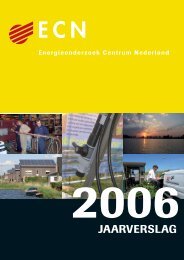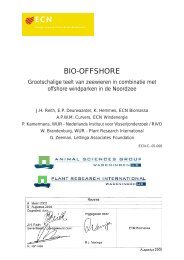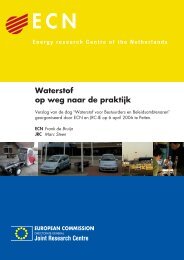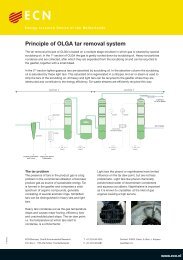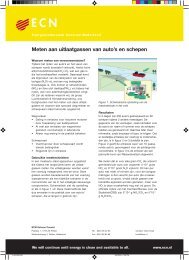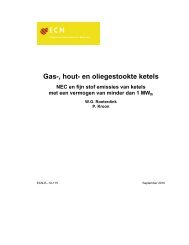PDF format (503 kB) - ECN
PDF format (503 kB) - ECN
PDF format (503 kB) - ECN
Create successful ePaper yourself
Turn your PDF publications into a flip-book with our unique Google optimized e-Paper software.
What are the dynamics of the materials system; is long-term planning possible and sensible ?<br />
The dynamics of the matarials system are determined by the pace of technological change and the life span of<br />
capital equipment. Regarding technological change, development of new technology for bulk materials requires<br />
a period of several decades from labscale to a significant section of the market. As a consequence of such slow<br />
system dynamics, long term planning is possible.<br />
Should technological development be considered in the analysis ?<br />
Technological development is one of the key driving forces that determine the system configuration. Within a<br />
time horizon of half a century, technology will change significantly. In the framework of the energy and materials<br />
system, major changes can be expected in power generation (gasification technology, new technology for<br />
renewables), in the transportation sector (fuel cells, electric vehicles, ethanol), for materials production<br />
(smelting processes for iron production, near net shape casting, biomaterials). Regarding product use, technological<br />
development seems to be a less important driving force. For recycling, cheap materials separation technology<br />
and improved recycling technology for plastics pose a challenge.<br />
How interact the improvement options in the materials system ?<br />
Significant emission reduction in materials production and electricity production reduces the cost-effectiveness<br />
of emission reduction in materials use.<br />
To what extent can materials options reduce greenhouse gas emissions ?<br />
The materials system can contribute up to 1200 Mt CO2-equivalents of emission reduction.<br />
How compare the costs of these materials related emission reduction options to the costs of energy related<br />
emission reduction options ?<br />
Emission reduction in the materials system contributes up to 50% to the total emission reduction for a fixed<br />
emission penalty. This figure shows that the costs are in line with the costs for emission reduction options in<br />
the energy system.<br />
Which strategies should be further developed (and which strategies not) ?<br />
Greenhouse gas emission penalties will have much more impact on materials production and waste handling<br />
than on materials consumption.<br />
End-of-pipe technology does already receive a lot of attention. More attention should be paid to feedstock<br />
substitution in the petrochemical industry, to improved materials quality, materials substitution/product redesign,<br />
and to the GHG consequences of future waste management technologies. Carbon storage in products<br />
seems a less relevant strategy at acceptable emission penalty levels. The potential for increased recycling seems<br />
to be limited.<br />
It is possible to achieve a factor four reduction in the greenhouse gas emissions in the materials system through<br />
an improved materials efficiency of the economy without affecting the lifestyle. A factor 10 is not possible with<br />
the improvement options and demand growth paths that have been considered in this study. Product re-design,<br />
increased product life and improved materials quality are examples of promising options that are not yet fully<br />
included in the calculations. More attention for this type of improvement strategies is warranted.<br />
References




